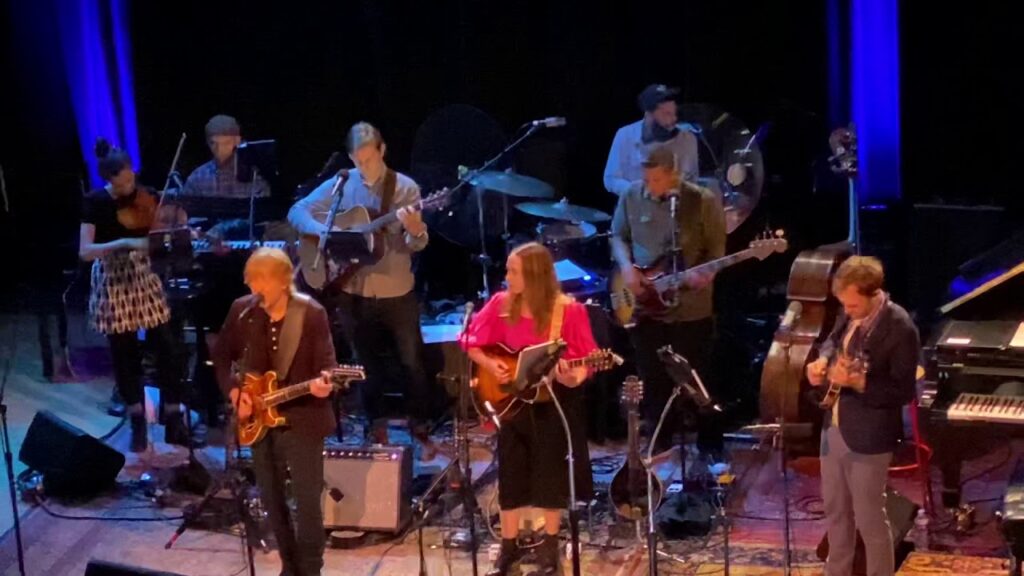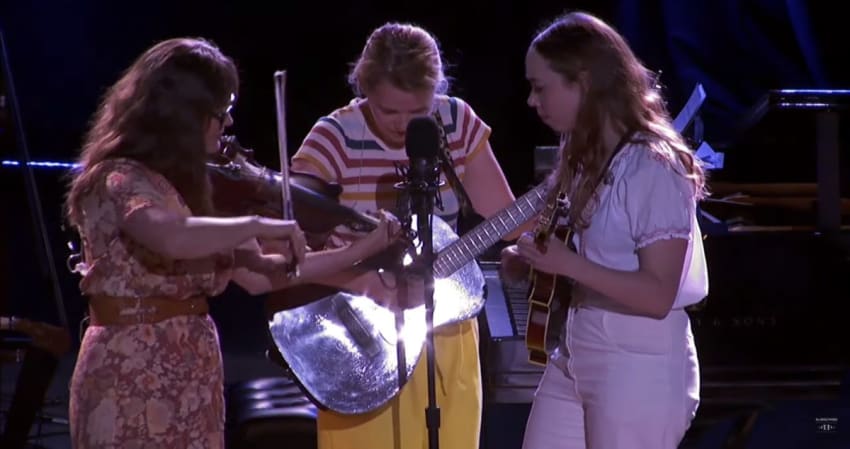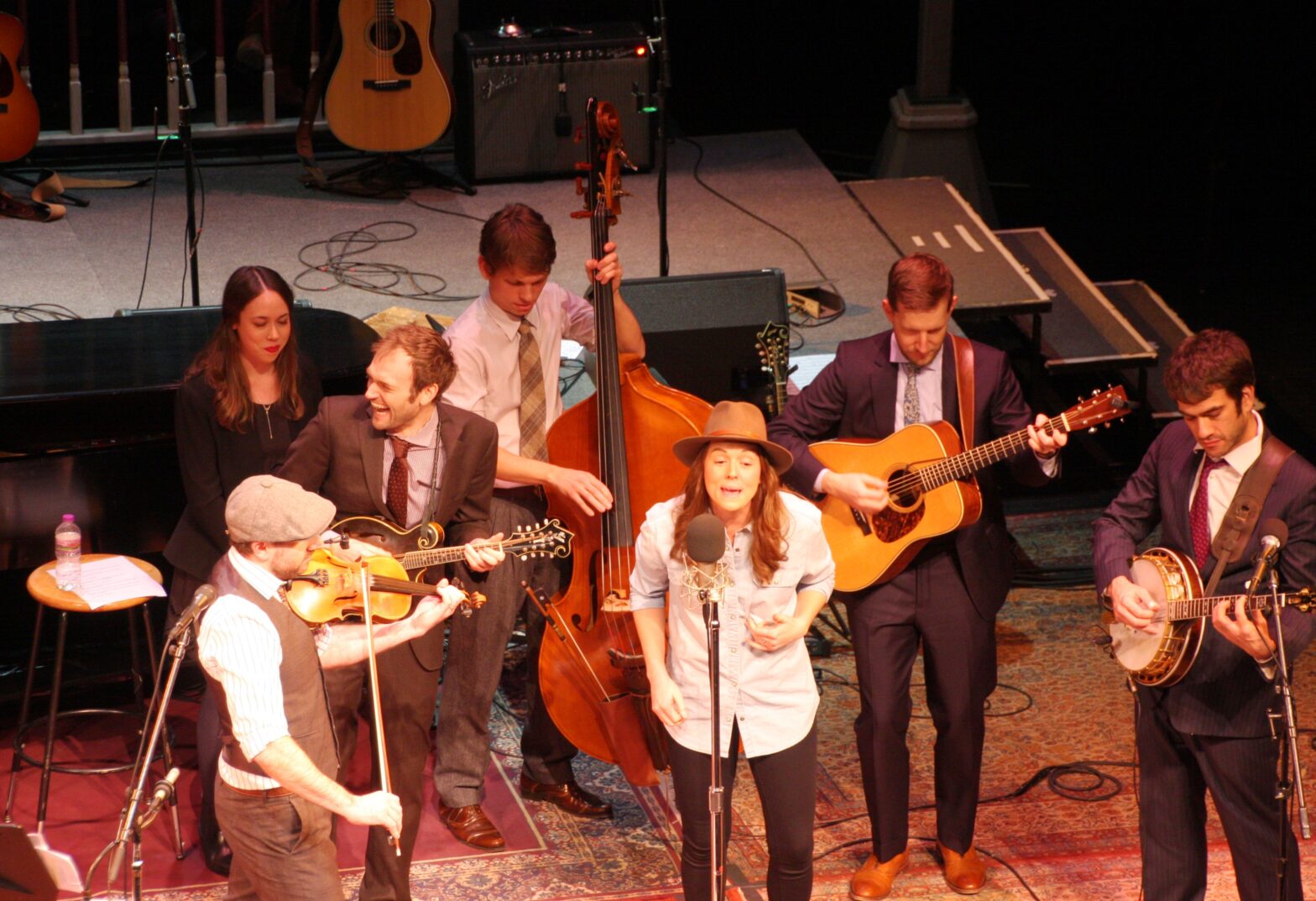[This post originally appeared on June 20th, 2020]
Live From Here, a modern musical giant, is no more. Its parent, American Public Media, announced that LFH is yet another victim of Covid-19. When you can’t gather musicians and their fans together to celebrate live music, there’s not much alternative. I come here to bid it good-bye, and say thank you.
I converted to LFH in November of 2016. I was reeling from the Presidential election, and that was even before we knew just how unspeakably awful things were going to get. As if to wink out the last star in an ink-black night, the Universe took Leon Russell from us on November 13th. That Saturday, I was listening to the newly rebranded Live From Here. [1] At the end of the show, host and lead musician Chris Thile stepped up to the mic and said, “Oh man, we lost Leon Russell last week.” Here was a guy just a year older than my elder son, bowing to one of my musical heroes. He then gave a quick but accurate summary of Russell’s work, ending with, “He’s basically on every record you love.” Then they played a Leon Russell song. Not Song for You or Delta Lady – probably his most recognizable pieces. No, they played Prince of Peace, which reminds us that anybody we encounter in the street “… might be the Prince of Peace returning.” With no less than Trey Anastasio on guitar. I was 100% certain that the song choice was not a coincidence. These are my people – I am part of their congregation.

The constant refrain from the LFH stage was that music is more than a pastime. It is a central force of healing and harmony. And they were determined to spread that beauty as far and wide as they could in their two hours on the radio. Every Saturday, they’d hold a church of love and music at some lucky venue somewhere in the U.S.
And what an army for love it was. The LFH band, though it would morph and shift personnel, was always embarrassment of musical riches. I just want to type their names. Starting from the bass players: Mike Elizondo, Paul Kowert, Alan Hampton, Chris “Critter” Eldridge, Julian Lage, Brittany Haas, Gabe Witcher, Jeremy Kittel, Alex Hargreaves, Rich Dworsky, Brett Williams, Gabriel Kahane, Brad Mehldau, Ted Poor, Nate Smith, Marcus Gilmore. And the women who acted as foils for Thile and melted us with their singing and playing: Madison Cunningham, Sarah Jarosz, Gabby Moreno, Aoife O’Donovan, Rachel Price.
But the main celebrant was Thile, a once-in-generation mandolin player and McArthur Genius Grant recipient. When he played, his facial expressions and body language told you everything. No matter the musical genre, or whether he was in a lead or subordinate role, at that moment, in that place, he was playing the greatest music of all time, and he was all-in.
And speaking of genres, Live From Here personified the ethos that many music lovers live by: “There are two kinds of music: good and bad.” If it was good music, LFH was all about it. Nowhere was this more evident than the Musician’s Birthday segment (“It’s been a hell of a week for musicians’ birthdays!”). The band and singers would celebrate a handful of notable musicians’ birthdays with snippets of music. Multiple centuries? No genre duplicated in the list? “No problem – we got this.” And they did got it, because of the consummate virtuosity of every last person onstage. Check out this survey of Maybelle Carter, David Byrne, Peter Illych Tchaicovsky, bluegrass fiddler Benny Martin, and Stevie Wonder.

This seemingly effortless excellence made it possible for them to throw out the script on occasion. For a while, Thile would take tweets during a break, pick one (live, on stage) and tell the band, “Okay – we’re going to play <random tune>.” Or “Fiddle Tune Request Time”, where they took requests from the audience (“No! That one has words!”) and then played a medley of those tunes, each one probably better than you’ve ever heard it before, from just a wispy outline of a plan. Check this out: Thile, Chris Eldridge, and Jeremy Kittel dance across three classics. Watch bassist Mike Elizondo, a musical behemoth himself, grinning with delight at his stereo-center seat for the show.
This cauldron of musicality’s gravitational pull attracted giants old and new. Paul Simon, David Crosby, Randy Newman, Bruce Hornsby, Mandolin Orange, Vulfpeck, Emmanuel Ax, Milk Carton Kids, Pixies, Anaïs Mitchell, Common, Gregory Alan Isakov. The names go on. And so many of those names I didn’t know until I saw them on the LFH stage. They were in Durham, NC – my college hometown – and Thile said, “I have some friends in a band here and we thought it would be cool to have them on. So, please lose your minds for… Sylvan Esso!” Me: “Sylvan who?” Audience: [loses its mind]. And it went the other way. In St. Louis, they had the entire St. Louis Symphony Orchestra, led by Gemma New. I thought, “How many of the people in the audience have never seen a professional symphony orchestra live? And how many of those people are going to have their minds blown?” If the audience response to Mozart was any indication, quite a few.
Let’s talk about the audience. AKA “the congregation”. I was in it a handful of times, and it was, indeed, church. The crowd was musically hip, politically liberal, and ready to go wherever the LFH bus went. Yes, they – we – were canonical “NPR”, but if the Sunday go-to-meeting clothes fit, wear them with pride. They sang along, they participated (I will forever regret that I never got to yell “Old Dangerfield!” for Fiddle Tune Request Time). And they applauded and cheered their brains out for whatever happened onstage. They were as much a part of the experience as Thile and the other musicians; without them, the show simply couldn’t be.
Before I go, I will leave you with a smattering of hints for mining the Live From Here vein. I can only wish for you that you’ll disappear into it for hours and come out centered, warmed, and content.
- The band plays Weather Report’s River People. You need to listen to this twice. The first time, just enjoy the groove, not least Thile’s body language when the synth fires up. And dig Brittany and Critter, both of whom grew up in the bluegrass world, crushing jazz fusion. The second time through, close your eyes and focus on Mike Elizondo channeling Jaco Pastorius on bass.
- Sarah Jarosz is a Grammy-winning singer, songwriter, and instrumental virtuoso. She all but defines the “Americana” genre. But LFH allowed her to release her inner Liz Fraser, [2] Natalie Maines, and Billie Eilish.
- Here’s a sense of the musical virtuosity onstage. Violin legend Hillary Hahn plays the Bach Double Violin Concerto with Thile. But the unsung hero here is bass deity Paul Kowert, whose continuo work provides the entire foundation on which the melody rests. I’m a bass player – I know how hard this is – but Kowert does it with a delicate touch and pure elegance. I’m actually a bit miffed because Hahn never gives him the time of day during the piece. I hope and trust that she gets how crucial his contribution is, but I wish she’d at least tossed one look his way.
- One of the best segments of the show was the occasional “Fast AF Fiddle Tunes”. [3] Here’s Brittany Haas “taking us to fiddle camp.” I first learned of the tune Half Past Four here and it’s become a favorite. Note during that one where Sarah Jarosz, back on home fiddle tune turf, frails the hell out of the piece, looking completely blissed out. Every time I watch this video, I see her and the others’ faces and think, “This is why we play music. For those moments when we are floating in a bubble of sound and beauty with our fellow players.” There isn’t a better feeling.
N.B. to the violin/fiddle players: Occasionally Brittany lifts her head off the fiddle’s chin rest, destroying the classic violin player posture. But then she looks like the old Appalachian fiddlers, many of whom played with the fiddle tucked up against their shoulder. My narrative is that Brittany has simply surrendered the instrument to a previous incarnation of herself, who was born in 1896 in southwestern Virginia. - You can’t talk about Live From Here without talking about Aoife O’Donovan. She was one of the most frequent Thile foils at the pulpit, and they have a special musical bond. She sometimes performs with Punch Brothers (he calls her “The first Punch Sister”) and she was the only guest musician on the Goat Rodeo sessions (i.e. she was jamming with Yo-Yo Ma). Here she is singing happy birthday to Joni Mitchell. Listen to the audience swoon.
- Sara Watkins, the fiddle superstar of Nickel Creek and I’m With Her, owns the stage and puts the audience in her pocket with this cover of Nikka Costa’s Like A Feather. Pure attitude.
- If you’re into music, you know how complex and layered Good Vibrations is. It’s Brian Wilson at the height of his compositional and studio engineering craft. Nobody would dare try to reproduce it live. Unless you’re Live From Here. Then you just mix Punch Brothers with I’m With Her, add Rich Dworsky and Ted Poor, cue the Farfisa organ, and you’re off to the beach.
- I’ll end with this. Here, Thile summarizes the Live From Here credo, the audience sings along, and for a few minutes, in the midst of nothing being right, all is right with the world.
I remember 1980 vividly. Reagan was elected and I was scared. A month later, John Lennon was murdered, and I wondered how we’d survive. Somehow we did, and 28 years later, I’d sit in an Asheville movie theater with tears of joy in my eyes watching a Black man being sworn in as President. The night came crashing back down just eight short years later, and in its aftermath Leon Russell was gone. I wish that in 1980 there’d been the light in the darkness that I’ve had the past four years, bringing me musical solace every Saturday, Live, From Here.
If you are a member of the LFH production family – whether your name is Chris Thile or you are the person who laid out the sandwiches backstage – thank you. You have brought musical beauty into my life and I am better for it.
Pax vobiscum.
_____________________________________________________________
[1] LFH was technically a continuation of Garrison Keillor’s Prairie Home Companion. They had wisely distanced themselves from him and PHC – you can look up the details.
[2] Here’s where you see Thile investing 100%, no matter his role. The mandolin is playing a part done by a programmed percussion generator. Doesn’t matter – if he is to be an echoing slow-decay percussion machine, then he will be the best one of those there is. Note also Noam Pikelny, the Bela Fleck of his generation. Another synth part. Another perfectly executed repetitive drone, by hand. This is consummate musicianship.
[3] Sadly, it too got rebranded, probably a nod to the family-friendly format. But the intent was always there.
